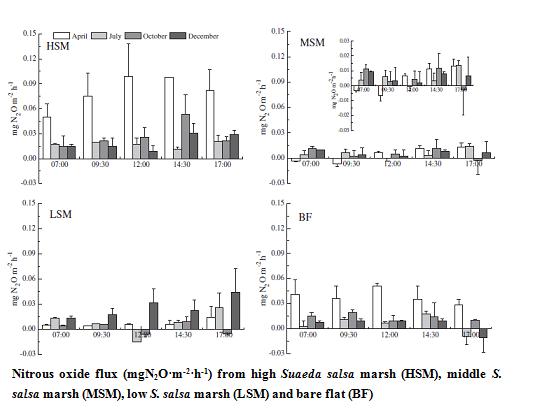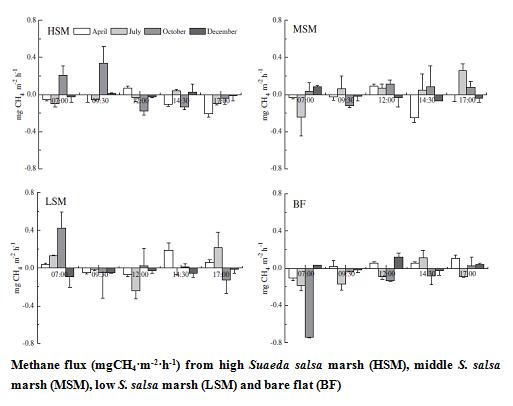| Research |
| Location:Home > Research > Research Progress |
| Trace Greenhouse Gases Emissions of the Yellow River Estuary help to accurately estimate the C emission from intertidal zone |
Nitrous oxide (N2O) and methane (CH4) are key radiatively active greenhouse trace gases which have been recognized to contribute global warming by 5% and 25%, respectively. Quantification of the trace gases is a subject of great interest because accurate information is required to determine the contribution of these gases to global greenhouse gas fluxes. Coastal marsh ecosystem is characterized by high temporal and spatial variations involved with topographic feature, environmental factors and astronomic tidal fluctuation. Above all, the intertidal zone between terrestrial and aquatic coastal ecosystems may represent a high dynamic interface of intense material processing and transport, with potentially high decomposition and associated greenhouse gases emission. In the past two decades, considerable efforts have been made to quantify the N2O and CH4 fluxes in different coastal ecosystems. In China, the studies on N2O and CH4 emissions from coastal marshes started quite late (in the 2000s), and the related research primarily focused on the coastal tundra marshes in Antarctica and the coastal marshes in the Yangtze River estuary and the Min River estuary. However, few studies have reported on coastal marshes in northern estuaries, such as This study identified the spatial and temporal variations of N2O and CH4 emissions and determined the key affecting factors based on two years in situ data. Dissimilar to previously published results, seasonal variations of N2O fluxes were not dependent on temperatures, but were related to the limited carbon (C) and mineral N in sediments during summer and autumn and the frequent freeze/thaw cycles in surface sediments during spring and winter. Seasonal variations of CH4 fluxes were also not dependent on temperatures. CH4 emissions were related to the interactions of abiotic factors (sediment moisture and salinity) and the variations of limited C and mineral N in sediments. For another, they were closely correlated with sulfur (S) biological cycling. The total sulfur (TS) and sulfate (SO42-) were abundant in sediments and the S biological cycle coefficients were high (0.8625~0.9014), indicating that both SO42- dissimilatory reduction process (performed by sulfate reducing bacteria, SRB) and microbially mediated AOM (anaerobic oxidation of methane) process (performed by a consortium of anaerobic methanotrophic archaea (ANME) and SRB) would be enhanced under anoxic condition, which further inhibited CH4 emissions. From the perspective of C and S coupling, the mechanism could better explain why the CH4 emissions across the intertidal zone were very low. It also evaluated the global warming potential (GWP) of N2O and CH4 emissions and the effects of N loading on emissions. Dissimilar to previous results, large spatial variations of N2O and CH4 fluxes (especially CH4) across the intertidal zone were observed (158.3% and 7856.3%, respectively). Also, the importance of seasonal N2O or CH4 contributions (particularly during non-growing season) to the estimation of local N2O or CH4 inventory was highlighted. This study also showed that N2O and CH4 emissions from the intertidal zone would be enhanced with increasing N loading to the Professor Bodelier (
|
| Appendix Download |
|
|

